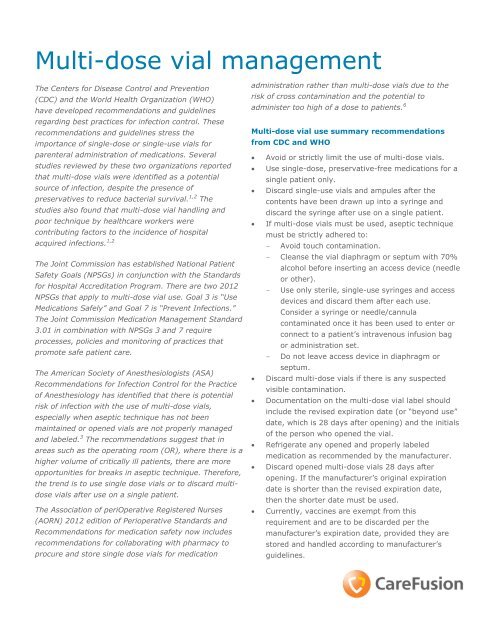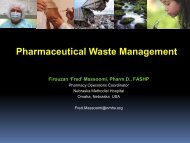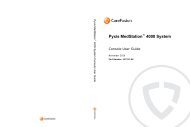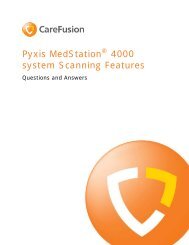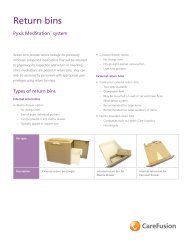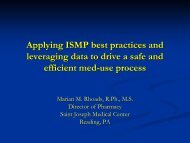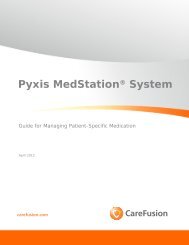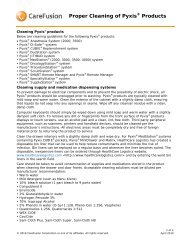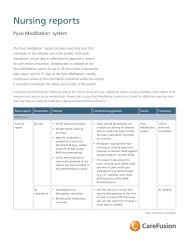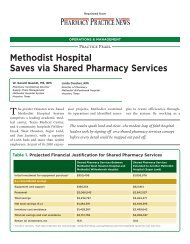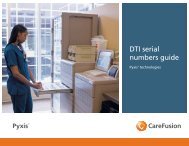Multi-dose vial management - The Pyxis ® Insider newsletter
Multi-dose vial management - The Pyxis ® Insider newsletter
Multi-dose vial management - The Pyxis ® Insider newsletter
Create successful ePaper yourself
Turn your PDF publications into a flip-book with our unique Google optimized e-Paper software.
<strong>Multi</strong>-<strong>dose</strong> <strong>vial</strong> <strong>management</strong><strong>The</strong> Centers for Disease Control and Prevention(CDC) and the World Health Organization (WHO)have developed recommendations and guidelinesregarding best practices for infection control. <strong>The</strong>serecommendations and guidelines stress theimportance of single-<strong>dose</strong> or single-use <strong>vial</strong>s forparenteral administration of medications. Severalstudies reviewed by these two organizations reportedthat multi-<strong>dose</strong> <strong>vial</strong>s were identified as a potentialsource of infection, despite the presence ofpreservatives to reduce bacterial survival. 1,2 <strong>The</strong>studies also found that multi-<strong>dose</strong> <strong>vial</strong> handling andpoor technique by healthcare workers werecontributing factors to the incidence of hospitalacquired infections. 1,2<strong>The</strong> Joint Commission has established National PatientSafety Goals (NPSGs) in conjunction with the Standardsfor Hospital Accreditation Program. <strong>The</strong>re are two 2012NPSGs that apply to multi-<strong>dose</strong> <strong>vial</strong> use. Goal 3 is “UseMedications Safely” and Goal 7 is “Prevent Infections.”<strong>The</strong> Joint Commission Medication Management Standard3.01 in combination with NPSGs 3 and 7 requireprocesses, policies and monitoring of practices thatpromote safe patient care.<strong>The</strong> American Society of Anesthesiologists (ASA)Recommendations for Infection Control for the Practiceof Anesthesiology has identified that there is potentialrisk of infection with the use of multi-<strong>dose</strong> <strong>vial</strong>s,especially when aseptic technique has not beenmaintained or opened <strong>vial</strong>s are not properly managedand labeled. 3 <strong>The</strong> recommendations suggest that inareas such as the operating room (OR), where there is ahigher volume of critically ill patients, there are moreopportunities for breaks in aseptic technique. <strong>The</strong>refore,the trend is to use single <strong>dose</strong> <strong>vial</strong>s or to discard multi<strong>dose</strong><strong>vial</strong>s after use on a single patient.<strong>The</strong> Association of periOperative Registered Nurses(AORN) 2012 edition of Perioperative Standards andRecommendations for medication safety now includesrecommendations for collaborating with pharmacy toprocure and store single <strong>dose</strong> <strong>vial</strong>s for medicationadministration rather than multi-<strong>dose</strong> <strong>vial</strong>s due to therisk of cross contamination and the potential toadminister too high of a <strong>dose</strong> to patients. 6<strong>Multi</strong>-<strong>dose</strong> <strong>vial</strong> use summary recommendationsfrom CDC and WHO Avoid or strictly limit the use of multi-<strong>dose</strong> <strong>vial</strong>s. Use single-<strong>dose</strong>, preservative-free medications for asingle patient only. Discard single-use <strong>vial</strong>s and ampules after thecontents have been drawn up into a syringe anddiscard the syringe after use on a single patient. If multi-<strong>dose</strong> <strong>vial</strong>s must be used, aseptic techniquemust be strictly adhered to: Avoid touch contamination. Cleanse the <strong>vial</strong> diaphragm or septum with 70%alcohol before inserting an access device (needleor other). Use only sterile, single-use syringes and accessdevices and discard them after each use.Consider a syringe or needle/cannulacontaminated once it has been used to enter orconnect to a patient’s intravenous infusion bagor administration set. Do not leave access device in diaphragm orseptum. Discard multi-<strong>dose</strong> <strong>vial</strong>s if there is any suspectedvisible contamination. Documentation on the multi-<strong>dose</strong> <strong>vial</strong> label shouldinclude the revised expiration date (or “beyond use”date, which is 28 days after opening) and the initialsof the person who opened the <strong>vial</strong>. Refrigerate any opened and properly labeledmedication as recommended by the manufacturer. Discard opened multi-<strong>dose</strong> <strong>vial</strong>s 28 days afteropening. If the manufacturer’s original expirationdate is shorter than the revised expiration date,then the shorter date must be used. Currently, vaccines are exempt from thisrequirement and are to be discarded per themanufacturer’s expiration date, provided they arestored and handled according to manufacturer’sguidelines.
pharmacy and financial systems must be able to receivethe desired billing and credit quantities from the <strong>Pyxis</strong>product interface. <strong>The</strong> testing should include end userssuch as anesthesia providers and nurses workingthrough their processes. End users should test all of theprocess steps from dispensing to the transfer of multi<strong>dose</strong><strong>vial</strong> quantities via the <strong>Pyxis</strong> Anesthesia system withthe My Items and/or Transfer to Patient featuresactivated.Policy and procedureClearly outline the processes for the <strong>management</strong> ofmulti-<strong>dose</strong> <strong>vial</strong>s for pharmacy, anesthesia providersand other applicable clinical end users in the <strong>Pyxis</strong>system policy and procedure. <strong>The</strong> defined processesfor replenishment and dispensing should be part ofuser training. Include all dispensing scenarios:individual patient and transfer processes for the MyItems and Transfer to Patient features, ifapplicable.TrainingInclude training on the handling of multi-<strong>dose</strong> <strong>vial</strong>s inimplementation training as well as ongoing new usertraining for the <strong>Pyxis</strong> Anesthesia System. Anesthesiaproviders and other clinical end users require trainingon dispensing, wasting and returning. Pharmacy staffrequires training on loading, refilling, unloading andsupporting clinical end users on multi-<strong>dose</strong> <strong>vial</strong>process questions..Sources1 Bulletin of the World Health Organization 2003; 81:491-500.2 Centers for Disease Control and Prevention (CDC): Preventing Transmission of Infectious Agents in Healthcare Settings 2007, RecommendationIV.H. Safe Injection Practices.3 American Society of Anesthesiologists: Recommendations for Infection Control for the Practice of Anesthesiology, second edition, 1999.4 <strong>The</strong> Joint Commission: “Standards FAQ Details” on <strong>Multi</strong>-<strong>dose</strong> <strong>vial</strong>s (July 20, 2010).5 Centers for Disease Control and Prevention (CDC): Safe Injection Practices to Prevent Transmission of Infections to Patients, May 21, 2010.6 ISMP Medication Safety Alert-Acute Care Newsletter January 26, 2012.© 2012 CareFusion Corporation or one of its subsidiaries. All rights reserved. <strong>Pyxis</strong>, <strong>Pyxis</strong> MedStation system, and <strong>Pyxis</strong> Anesthesia system aretrademarks or registered trademarks of CareFusion Corporation or one of its subsidiaries. All other trademarks are the property of their respectiveowners.CareFusion© Copyright block 5.5/6 is frutiger roman. Equi tatum eugait ex eugiam inibh erit irit, quatuerat ipsusto eugait lorpero. Cid quatus que niatus, quidusSan perovid Diego, magnim CA volorem que ne eaque vit quam, offic tectota tentiscilias il id ea et moloratem sit quossusae. Itaquae si in prorporeprae pe re laborrorevelique non corem. Tem estiorrum escienis consequ idiores mo cum inusaep erspide qui diasped quam et facias es eiusaest, nectatem cusdam harci temolorere.carefusion.com


